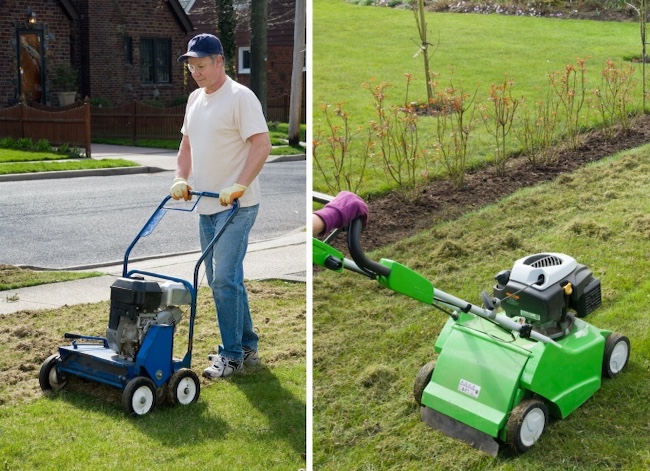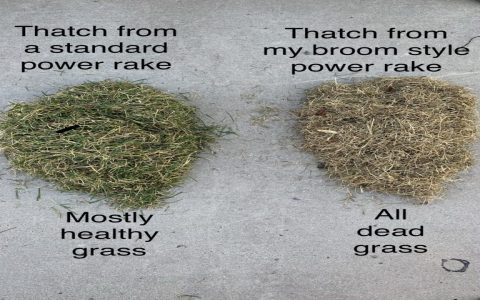Both power raking and dethatching are methods to remove thatch – a layer of dead grass, roots, and other organic debris that accumulates between the green vegetation and the soil surface. While both aim to improve lawn health, they differ in intensity and application.
Power Raking
Power raking is a mechanically aggressive process designed to remove a very thick and compacted layer of thatch, typically more than 3/4 inch to 1 inch deep. It uses robust, rotating flail-like blades or tines that dig deep into the thatch layer, often reaching the soil surface. This method is more invasive and is generally reserved for lawns with severe thatch problems that significantly impede water, nutrient, and air penetration to the soil.
Key characteristics of power raking:

- Highly aggressive thatch removal.
- Effective for very thick thatch layers (over 3/4 inch).
- Blades typically make contact with the soil.
- Can be stressful for the lawn, requiring a longer recovery period.
- Typically performed less frequently, only when thatch is severe.
Dethatching
Dethatching is a less aggressive method for removing a moderate layer of thatch, usually between 1/2 inch and 3/4 inch. Tools used for dethatching, which can include manual rakes, tow-behind dethatchers, or specialized machines often called vertical mowers or scarifiers, use spring tines or knife-like blades. These implements lift or cut through the thatch layer without being as invasive as a power rake. Dethatching is often part of regular lawn maintenance to prevent excessive thatch buildup.
Key characteristics of dethatching:
- Moderately aggressive thatch removal.
- Suitable for thatch layers of 1/2 to 3/4 inch.
- Tines or blades are generally set to skim above the soil or lightly score it.
- Less stressful on the lawn compared to power raking.
- Can be performed more regularly, often annually or biannually.
Core Differences Summarized
- Aggressiveness & Depth: Power raking is significantly more aggressive and penetrates deeper into the thatch, often disturbing the soil. Dethatching is gentler and works closer to the surface of the thatch layer.
- Thatch Level Addressed: Power raking is for heavy, severe thatch. Dethatching is for light to moderate thatch.
- Equipment: Power rakes use heavy-duty flails or knives designed for deep thatch. Dethatching equipment ranges from simple tines to less aggressive blades.
- Lawn Impact & Recovery: Power raking can cause more temporary damage and stress to the lawn, requiring a more extended recovery. Dethatching is generally less disruptive.
- Frequency: Dethatching can be a routine maintenance task. Power raking is a corrective measure for severe conditions and is done less often.
When to Choose
Choose power raking when your lawn has a thatch layer thicker than 3/4 inch to 1 inch that is causing significant issues with water, air, and nutrient flow. It's a more intensive renovation process.
Choose dethatching for routine maintenance when the thatch layer is between 1/2 and 3/4 inch thick. This helps prevent thatch from becoming a severe problem and maintains overall lawn health with less stress on the turf.
In both cases, these operations are best performed when the grass is actively growing to allow for quick recovery, typically in early spring or early fall for cool-season grasses, and late spring/early summer for warm-season grasses.











